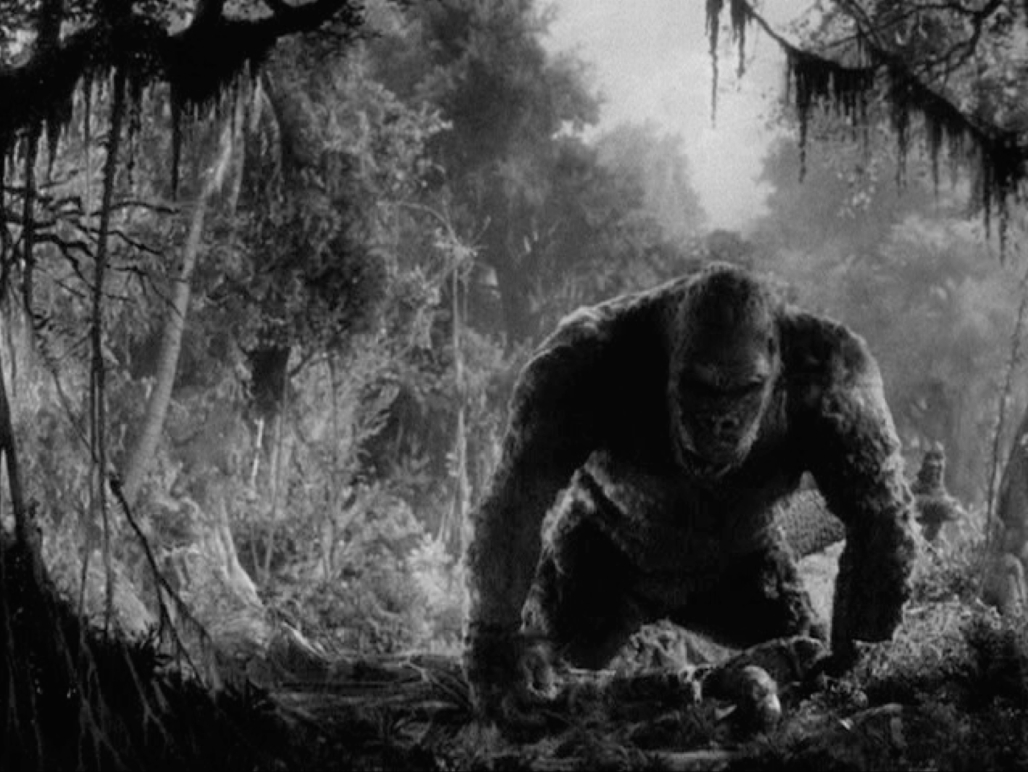
Opening note: More so and forever a fantasy-adventure film before it’s a science fiction film, I can still find a way to live with it on this list if I think hard about its theme of modern technology (of the time, gas bombs and biplanes) overtaking the absolute epitome of natural strength – that is, for the movie to be science fiction, it has to be seen as nature’s final bow at the hands of what is the unstoppable wave of the future. But that’s difficult for me. As you’ll see, I’m beyond emotionally ensnared by this film, and as long as the movie’s had its grip around me, I’ve only ever enjoyed it as the greatest of all monster-on-the-loose films, many of which are clearly science fiction, but this one’s not so obvious. I happily invite anyone in the comments to describe the movie’s relation to the genre at hand – I want to learn – but this paragraph will have to count as my only nod to that branch of the discussion.
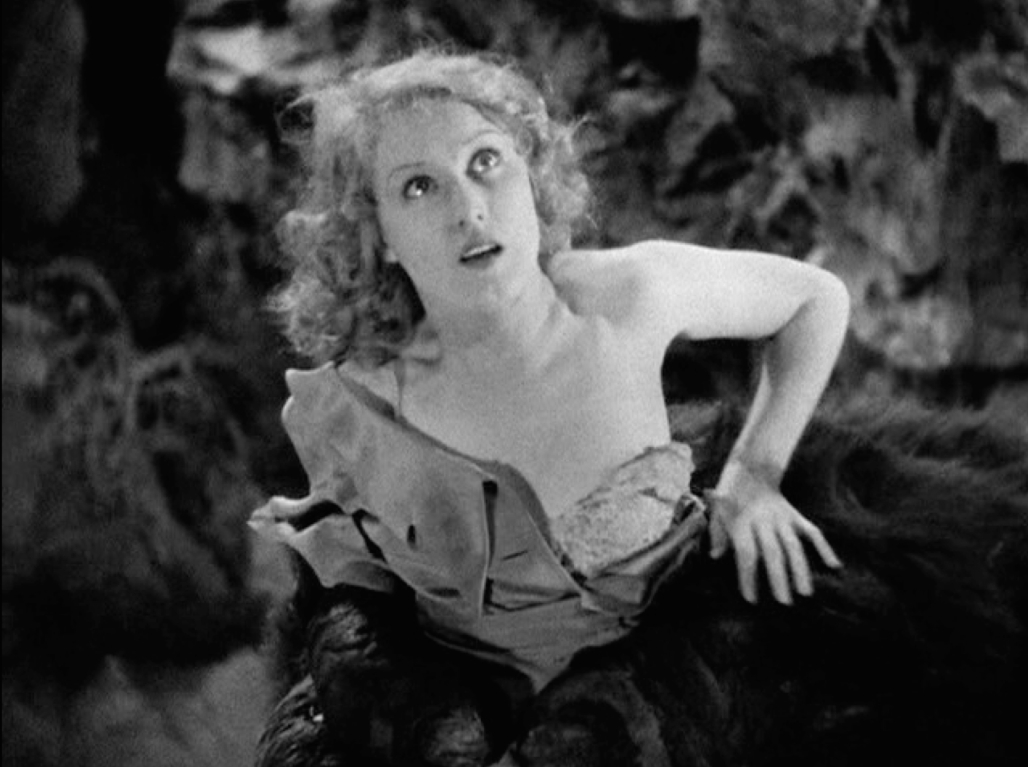
King Kong, the debated but still perversely entertaining 1976 remake, is the only movie that I can’t remember not knowing about. Meaning, one of my earliest memories of life is seeing a TV commercial for its theatrical release when I was a little squib of 5 years old. The cracking trees, the writhing woman bound to posts, and the horrible animal scream of the giant gorilla had me so irrevocably hooked on the idea of a giant gorilla that it’s never left my brain. I must’ve thrown a fit, cause my parents actually took me with them to see it. I still have a sort of chest flutter/muscle memory sort of feeling when I think about seeing that huge creature on that huge screen. After that, I drew gorillas incessantly. I imagined I was a gorilla, loping around the house, an action figure in my hand (or maybe my sister’s Barbie). I used to climb on top of fire hydrants and roar while swiping at invisible aircraft. I think I stopped doing that about my sophomore year of college. A year or so after the movie, though unrelated to the movie (so I thought), I bought my first book with “my own money”: Jeff Rovin’s 1977 From the Land Beyond Beyond, detailing all of Willis O’Brien’s work and all of Ray Harryhausen’s stuff up to his then-most-current movie, Sinbad and the Eye of the Tiger (with a quick sentence-long teaser for something in the works called Perseus and the Gorgon’s Head). Of course, I got the book because of the monsters I saw on every page, unaware at first that one of those movies was a very different version of my beloved King Kong. I essentially learned to read so I could read that book. When I finally understood it, over the next few years, I got to love stop-motion with a depth eclipsed by nothing else.
The book is still in my possession, now in three pieces, and it’s sitting right next to me as I write this. There’s a long and thorough chapter on O’Brien and one on that other King Kong, the original, and I’ve read them a million times. I read all about the original before I’d ever even seen it, which I finally did at some point during those years, probably on the weekly Saturday afternoon monster movie on TV (“Screaming Meemies Flicks”, San Antonio, TX, anyone?), and I was hooked all over again. This original version was something else, though – something that the new one wasn’t. I didn’t have the vocabulary then to describe what it was. It wasn’t just that it was black and white, or that it was airplanes instead of helicopters, or that one famous building was swapped for another. It wasn’t a superficial thing. It had something to do with atmosphere, feelings. Growing up, when they’d play the 1976 on TV, there was something like a harsh, real-movie, real-world quality to the experience. Like I was watching one of my parents’ movies. Real people talking about a real ape and what to do about it. When I’d watch the 1933 – usually on WTBS, as it was called then, and as it was labeled in the TV guide that I’d scour like a scientist for any and all monster movies playing anywhere on the dial that week – it was like watching a dream. I suspect many of you know what I’m talking about. But I’m getting ahead of myself. All I’m driving at is simply: I love this movie, and I don’t really know how to talk about it. It’s like someone told me to write a thousand words about my right arm. It’s so personal, so close, so attached. At the risk of over-sentimentalizing (further), let me just jump in. I think for some semblance of structure, I’ll give a quick run-down of the historical facts that most of us here probably already know by heart, then follow that with some observations on a couple of my favorite scenes.
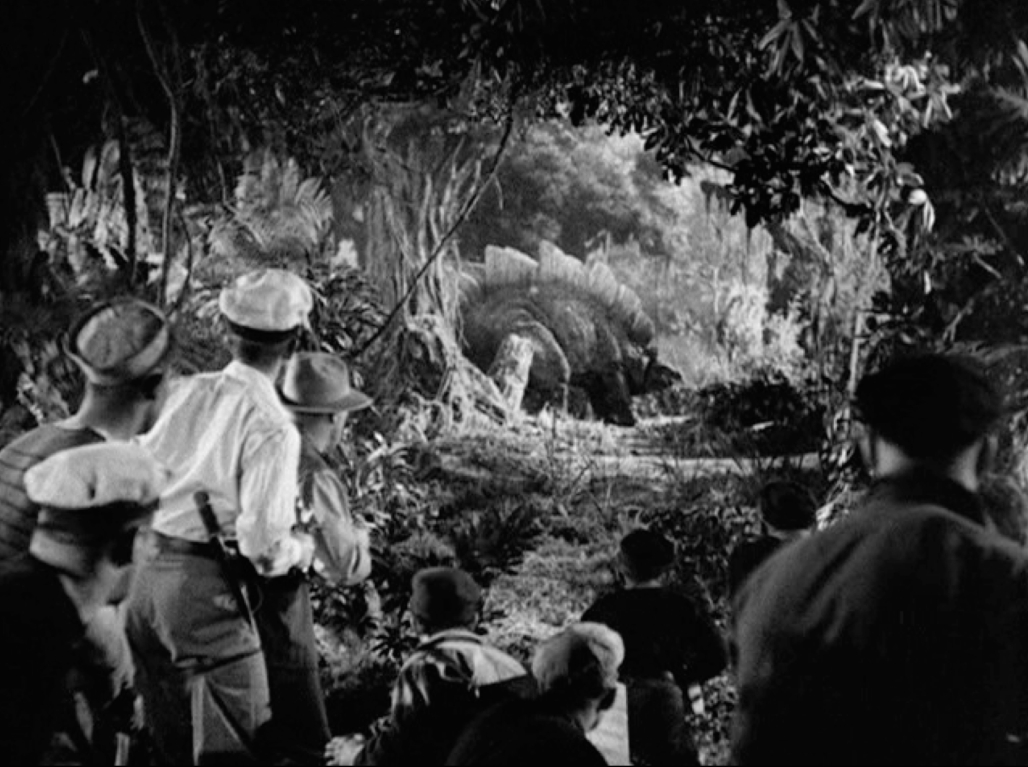
King Kong is the perfect creative confluence of two very different visionaries, adventurer-filmmaker Merian C. Cooper and special effects technician Willis O’Brien. In the early ’30s, the world was still a place where rumors of exotic animals and savage tribes wafted in on trade winds, gripping the imaginations of explorers, adventurers, and glory seekers. If a man had the right connections and could wrangle some cash, he could be on his way to Borneo or Sumatra or India, pushing through the unbroken branches of a mysterious virgin world, perhaps returning with first-won evidence of some forgotten or never-before-known animal. This was the air Cooper and future producing partner Ernest Schoedsack breathed. They traveled together, gathering filmed images of what they saw, bringing it back for the lecture circuit and some major bragging rights. And it was amongst these adventures that Cooper, already hooked on gorillas from childhood, first hatched his story idea of capturing a giant one and bringing it back to a disbelieving civilization.
Meanwhile, O’Brien was busy perfecting life, 1/24th of a second at a time. He earned his chops making short films with crudely built stop-motion dinosaurs in the lead roles for no one less than Thomas Edison, later teaming with a young sculptor out of Otis College in L.A. named Marcel Delgado with a similar affinity for Charles R. Knight’s beautiful renderings of day-to-day prehistoric life, and made a team effort out of the Arthur Conan Doyle storyThe Lost World. It was a big hit, and O’Brien and Delgado pivoted that success into a new project at RKO called Creation… but it was not to be. A certain explorer-turned-studio money watchdog saw how much of RKO’s cash was dropping into one project, and he put the kibosh on it. That man was Merian C. Cooper. I don’t have the documentation to prove it (someone show me, and I’ll be vindicated!), but I can’t help wondering if he purposely buriedCreation to make room for the giant ape story burrowing into his skull – knowing that O’Brien and company had the magical means to make his own dream come true. In any case, Cooper, now with the backing of RKO and O’Brien’s knockout bag of tricks, had the snare he needed to bring his giant ape home for the world to see.
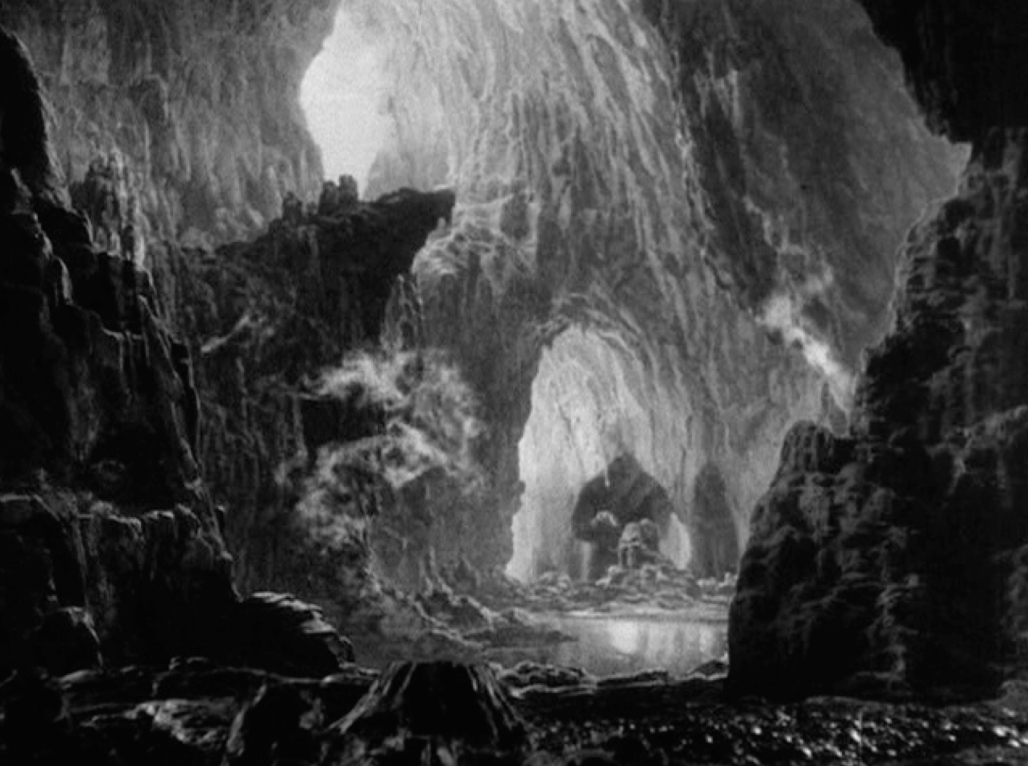
Over the next year, these two visionaries colluded on some of the greatest cinematic smoke-and-mirrors the world had ever seen. So many techniques were combined in a new way, or just outright invented, to create the effects desired, the project evolved into a bona fide paradigm shift in what film artists could do and what filmgoers could expect. In this way, I like to think of the Cooper-O’Brien relationship as not unlike what Welles and Toland had onCitizen Kane, constantly asking how to make something work, and then actually achieving a new and exciting look. And like Citizen Kane, there are moments in Citizen Kong – you were thinking it, too – that are so well done and perfect for their moment in the story, despite their surface, trapped-in-1933 markers, that they’ve yet to be bested. And the story they created, with the masterful shaping of a series of gifted writers – Edgar Wallace, James Creelman, and Schoedsack’s wife, Ruth Rose – along with the interweaving of Max Steiner’s groundbreaking music, was a rousingly dense amalgam of popular pulp elements, jungle movies, horror, comedy, pathos, and spectacle, and all framed by a recurring “beauty and the beast” refrain that lent the end product the quality of an unshakable American myth, a story that feels like it’s always been there, at once ancient and vital.
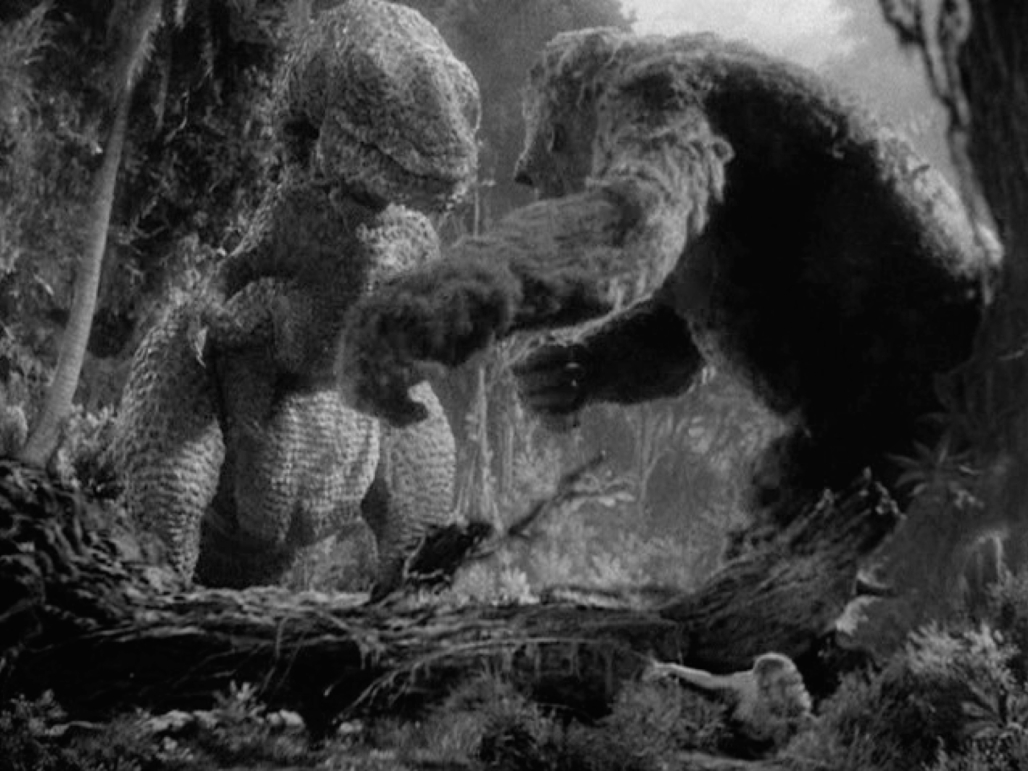
Instead of rolling out the whole plot, one we all know, allow me to expound a bit on some specific scenes:
THE TYRANNOSAURUS REX FIGHT
The preamble to this scene is, of course, the log roll. Men scramble to return to safety, crossing a huge fallen log that straddles two cliff-top edges of a deep, dry ravine. Kong expresses a robust simian glee – I’d not call it anger at this point – a kind of pranksterish delight in hefting the log into his grip and gently rolling it. We can see he’s got the strength to simply lift the thing and drop it into the ravine, killing all in a single move, but he chooses to torment the poor sailors. This is our introduction to the dark joy of death lurking in the heart of the beast. With whimsy, he twists and turns the weight of the fallen tree, watching as the men grasp at any protruding knot or twig for their very lives, then observes them falling one-by-one into the craggy pit. The fact that we get a ground-level shot of the men hitting the rocks, with suddenly stifled death screams, their bodies twisting into bent corpses, shows the morbid fun the filmmakers were having, too. Kong’s macabre sense of humor was not the result of an actor’s choice – it was Cooper’s and O’Brien’s. The thudding shock of those men hitting the stone gully must’ve been a new one to most who saw it in 1933.
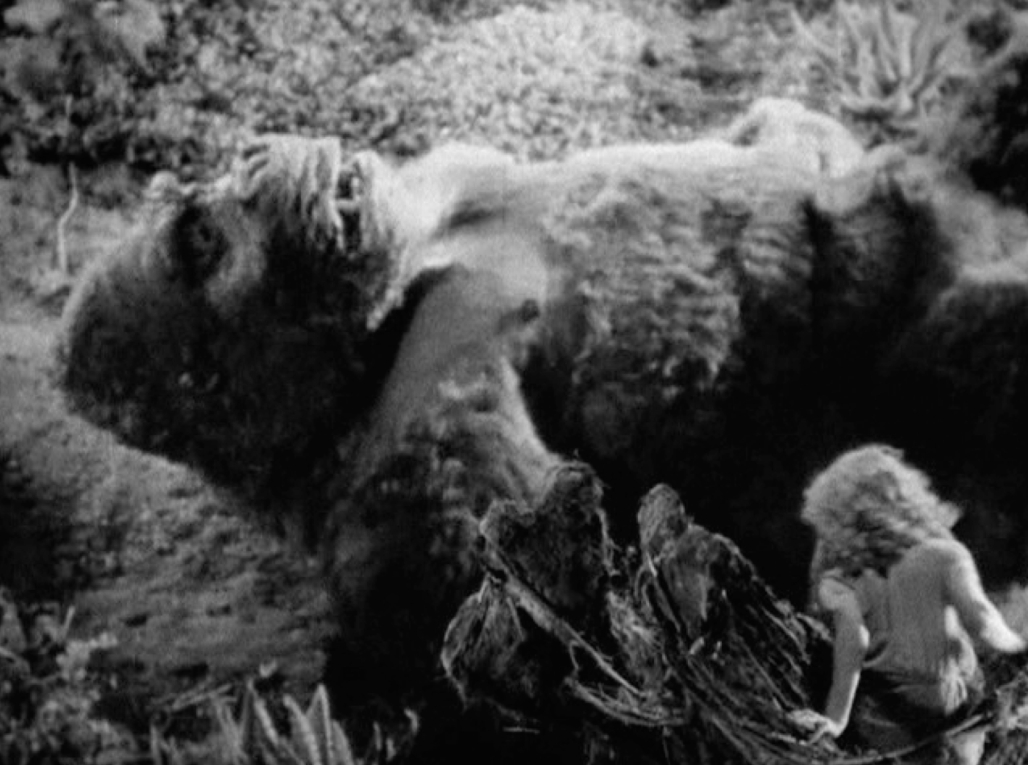
After some to-do with Driscoll and a strange, two-legged lizard, Ann’s screams summon Kong back to her side. There’s some hesitation in Kong, a very human male dilemma: can I keep fiddling around with what I’m doing, or should I check on my girl? In any case, he arrives to find an interloper in the midst: an amazingly-crafted and beautifully-articulated Tyrannosaurus Rex sniffing about the jungle floor. While Ann watches from her high vertical perch, Kong protectively engages the dinosaur in an all-out battle of brute strength. I will never get tired of watching this match-up. I’m not the first, and will never be alone in saying that it’s among the greatest special effects scenes ever created. The fact that the creators were starting with nothing – no filmic precedent or effects reference point but O’Brien’s own – is merely the foundation for appreciating what we’re seeing. The easy thing to do would be as few shots as possible, but what O’Brien commits to is a series of progressive angles, each lining up with Ann’s perspective, that taken together drum up as much engaging action and suspense as any live-action fight scene might. We experience several wide shots, still effectively from Ann’s POV, where we see the creatures in full, not just going through the stop-motions, but through a clearly choreographed dance that includes punches, bites, leaps, and flips – these opponents are thinking, taking their time between moves, circling, feeling out the other. Here in these wide shots, we have the visceral breadth of the fight played out through the leafy proscenium of the jungle, in the middle distance between Ann and that deep, decorated background. We’ve lived in that near-3D environment for twenty minutes of story, saw it used so well to enhance the charging ferocity of an oncoming Stegosaurus, but now the world of Skull Island is cinched together by the curdling savagery of its fiercest predators. Interspersed with the wide shots are pop-ins, still behind Ann’s head, but closer, the creatures right in front of her, highlighting just how close and how large they are. But amongst even these, the two shots that sell the reality of it all are 1) the felling of Ann’s perch – Kong’s back bumps the tree and it plummets, the camera fixed on Ann’s screaming terror all the way down, providing the sensation of falling with her into the foliage, and 2) before that, a single, one-second shot from atop Ann’s tree, looking down past her to the ground below, where Kong falls backward with a deep trembling of the earth – he gathers his wits and rises again, and we cut back to a wide shot. The payoff of that extra full day of animating is our yet-deepening realization of Kong’s great size. We know she’s high above the ground, Kong enters, landing on his back, but he still fills the frame. The movement, the thunderous reverberating of the ground, and the framing past the back of Ann’s head, all work to give us the jolt of shocking scale. It’s a moment of genius, a 35-frame glint of extra detail to show us that O’Brien had an understanding of what an audience needs to feel connected, invested, and entertained. But we’re not done yet. Once Ann is ground-level, so are the rest of the shots, retaining the vantage point of our audience surrogate until we’re at last past the moment of the dinosaur’s ultimate bone-cracking demise. I can talk all day about Kong’s playful curiosity re: the lizard’s crushed jaw, but I’d rather point out in the context of all of the above, the quick shot of Ann pulling away from Kong’s reaching hand – it’s a push-in on her face. I’m not encyclopedic on this movie, but is there another push-in anywhere else in the running time? I suppose if there were to be just one, that’s a perfect place for it, and, coming off the thoroughly organized, deeply effective scene that precedes it, it’s only further proof that a genius is manning the animation table.
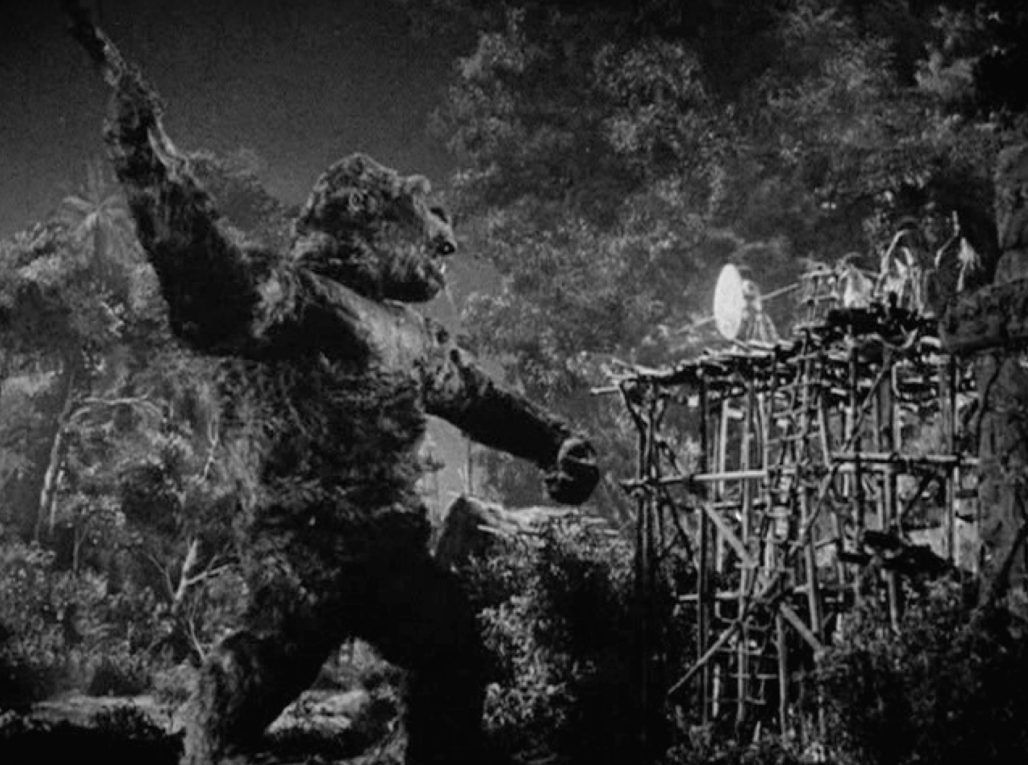
VILLAGE RAZING / DOWNTOWN RAMPAGE
The Manhattan rampage gets all the press, but the squashing of the Skull Island village is rightfully terrifying in a way the New York finale isn’t. When Kong arrives to retrieve his stolen love, it’s a somewhat safe leap to assume these villagers may have never seen the monster upset before. We don’t know how old Kong is, but his legend has at least been around long enough for a huge wall to get built and a veritable worship liturgy to be well-established in his honor – what to offer the god, how to present that gift unblemished, what to pray to beckon him to come. I like to think this generation of natives has lived in relative peace by these well-observed rituals, and that the enormous gate latch has been there since before the current chief was a twinkle in the medicine man’s eyes. Why else would they, when Denham announces Kong’s approach, run toward the gate to get a look-see? Their deity’s looming rage was outside their experience. What must those poor villagers have thought moments later as they saw Kong ripping their homes apart? To them, this primal melee is a supernatural event, a righteous rebuke from the lord of the jungle to never let outsiders futz with the legalism, a thunderbolt of wrath for their insipid complacency. Those who survived to assay the damage, while picking through the damage left behind after the departure of the meddling visitors, must have questioned their complicit hearts, must have judged themselves unworthy: not only must they have botched their offering, but their god was stolen away to boot, never to return. Without their wild god to appease, who will protect them from the rampaging prehistoric monsters still slithering through the jungle? One can assume that none of these questions passed through the minds of the New Yorkers witnessing a similar rampage down 5th Avenue. Though they were getting stomped and chewed, too, there’s no mythic dread or spiritual component, no sense that this is something that was brought down upon them by their own sin. If anything, Kong’s presence at all, and certainly his streak of destruction, is a highly unsettling re-penetration of untamed nature into their steel and stone world, their bow-tied palace of self-sufficiency. For the natives, the new absence of a god to worship is a problem; for the New Yorkers, the entire ordeal is a living passion play that ultimately re-asserts the religion of aggressive technology over primitive unruliness. Denham’s final comments over the defeated Kong are said, if you’ll notice, with a bit of a shrug, implying not so much a mournful “God is dead” but perhaps a relieved “finally, noblesse oblige is dead”, and the modern world is safe again to build glass spires unto itself.
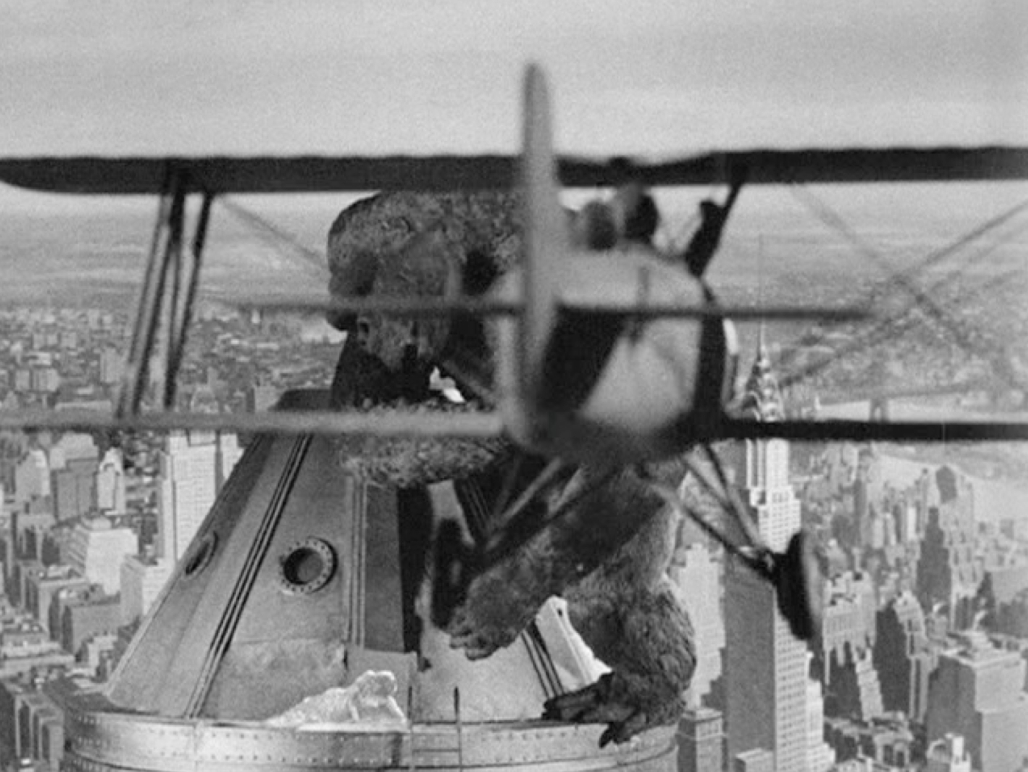
Also, while both the city and village scenes document a creature unhinged, the village scene especially should have wiped away all sympathy for the beast, as his destruction is so wanton, so deliberate, and less justified by fear. The village is Kong tearing through the house looking for his lost set of keys, not Kong tearing through the city, a wounded animal trying to find some familiar respite. The village razing is the first we see of Kong shoving terrified people into his maw. It’s horrifying, and yet… there’s a weird quality in Kong’s demeanor in these moments, almost like he’s doing this for the first time, trying it out, seeing how hard he has to clench his jaw to crack a human back before spitting the person out into the mud. That experimental edge to his behavior lends it a sort of “toddler puts dirty dog toy in mouth” vibe. There’s something innocent about it. I point this out not to prove Kong is guiltless, but that it’s awfully strange and amazing that Cooper and O’Brien (but let’s be honest, mostly O’Brien) created a character that can do such horrible things, like eating people or crushing them into the earth with his feet, and still generate strong feelings of loss once he’s been dispatched by a hail of bullets. When Kong’s in his death throes atop the skyscraper, lashing out, inspecting wounds, holding Ann one final time, I’m never not a roiling mix of sad, impressed, nostalgic, and… bemused – that O’Brien made a puppet move in a way that expresses more about loss and love and sacrifice and death than a thousand “real” actors over a hundred years of cinema.
No comments:
Post a Comment